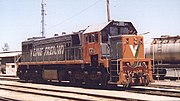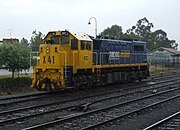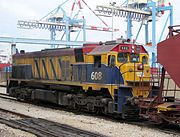
The 82 class are a class of diesel locomotives built by Clyde Engineering, Braemar for FreightCorp in 1994–1995.

The 90 class are a class of heavy haul diesel-electric locomotives built by Electro-Motive Division, Canada for FreightCorp and EDi Rail, Cardiff for Pacific National for use on high tonnage Hunter Valley coal workings.

The EMD G12 is a class of export locomotive built by GM-EMD, and its Canadian affiliate General Motors Diesel. In addition, Australian licensee Clyde Engineering built ten locomotives for New Zealand in 1957, five for Hong Kong, 23 for Queensland, fourteen for Western Australia and seven for BHP. Australian licensee Commonwealth Engineering also built 42 for Queensland Rail in 1964–66. Many examples were built in the 1950-1960s for railroads around the world.

The New South Wales 42 class was a class of diesel locomotives built by Clyde Engineering, Granville for the New South Wales Department of Railways in 1955/56.

The B class are a class of diesel locomotives built by Clyde Engineering, Granville for the Victorian Railways in 1952–1953. Ordered and operated by the Victorian Railways, they initiated the dieselisation of the system and saw use on both passenger and freight services, with many remaining in service today, both in preserved and revenue service. Some were rebuilt as the V/Line A class, while others have been scrapped.

The EMD G16 is a diesel locomotive built by General Motors in the US and under licence by Clyde Engineering in Australia and MACOSA in Spain. It has been used in Australia, Brazil, Egyptian Railways, Hong Kong, Israel Railways, Mexico, Spain, Yugoslav Railways and on the successor Croatian Railways, Slovenian Railways, Serbian Railways, Macedonian Railways, Republika Srpska Railways, Kosovo Railways and Railways of the Federation of Bosnia and Herzegovina.

The GT46C is a model of diesel-electric locomotive designed and built by Clyde Engineering using Electro-Motive Diesel components. A number of Australian rail freight operators purchased them from 1997: Westrail as the Q class, FreightLink as the FQ class, and Freight Australia as the single-locomotive V class. As of 2022, all 24 locomotives were owned by Aurizon following its purchase of certain One Rail Australia assets in July 2022.

The T class are a class of diesel locomotives built by Clyde Engineering, Granville for the Victorian Railways between 1955 and 1968.

The G Class are a class of diesel locomotive built by Clyde Engineering, Rosewater and Somerton for V/Line between 1984 and 1989.
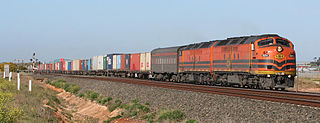
The CL class is a class of diesel locomotives built by Clyde Engineering, Granville for the Commonwealth Railways in several batches between 1970 and 1972. The class was the last in the world to be built with the Electro-Motive Diesel bulldog nose but differed from previous builds in having a mansard roof.

The GM class are a class of diesel locomotives built by Clyde Engineering, Granville for the Commonwealth Railways in several batches between 1951 and 1967. As at January 2014, some remain in service with Aurizon and Southern Shorthaul Railroad.

The diesel-hydraulic locomotive ML 2200 C'C' was a 6 axle variant of the DB Class V 200 series of locomotives, which were built for Yugoslav State Railways (JDŽ) by manufacturer Krauss-Maffei.

The GE U20C diesel-electric locomotive was introduced by GE Transportation Systems as an export model in 1964. It was powered by the 8-cylinder 7FDL-8 engine. This locomotive is used worldwide with many variations and modifications. Different engines may be used, e.g. 7FDL8 and 7FDL12. Like the other members of the Universal series, it can be built to suit all track gauges.

The JŽ 664 locomotives were a class of diesel locomotives operated by Yugoslav Railways. They are an GM-EMD export model of type EMD G26, subclass 664-0 was built by EMD, subclass 664-1 was built by Đuro Đaković from 1972 until 1984.
The AL class are a class of diesel locomotives built by Clyde Engineering, Rosewater for Australian National in 1976–1977. They were mechanically similar to the CL class but instead of a bulldog nose had two flat ended cabs, similar to the 422 class built for the New South Wales Government Railways in 1969.

The 2100 class is a class of diesel locomotives built by Clyde Engineering, Eagle Farm for Queensland Railways between 1970 and 1973.
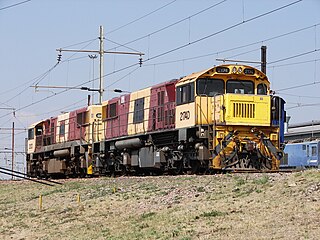
The Queensland Railways 2170 class is an Australian diesel-electric locomotive.
The 2250 class are a class of diesel locomotives rebuilt by Queensland Rail's Redbank Railway Workshops in 2004.

The EMD GT38AC diesel-electric locomotives are made by Electro-Motive Diesel for export in Indonesia. There are 91 locomotives owned by the state-owned Indonesian Railway Company, all of them are for in Sumatra and replace the aging EMD G26. It's also one of two most advanced-technology locomotive in Indonesia.


